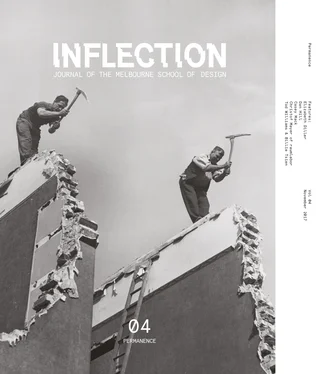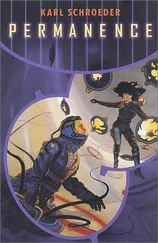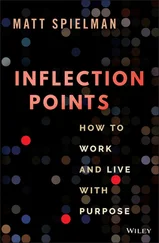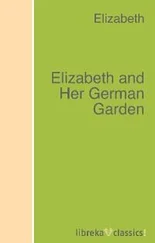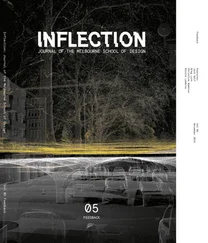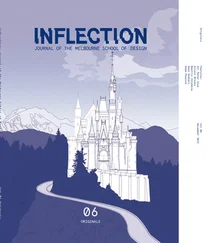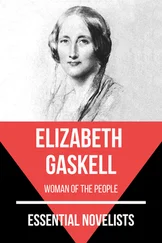Periodic time is the temporality of repetition, of habits turning into routine. Many of the temporary post-quake projects in Christchurch had repeating or periodic events. Saturday markets, rosters for watering the Agropolis urban farm, Tuesday night board games at a temporary venue called the Pallet Pavilion, open bike nights at RAD Bikes and motorbike Thursdays at a bar called Smash Palace. These became habitual and enabled the development of lifestyles and the formation of new habits. Agropolis was located in a visible central city location and these routines were experienced and witnessed not only by the groups of people that were attached to them, but also by users from the city’s surrounds. In this way, the daily rhythms of Agropolis created different kinds of syncopated, staccato and punctuated experiences of time in the city. These rhythms and patterns were created by particular relationships with other entities (plants, compost, seasons, calendars, events) and are not accounted for in the conventional temporal descriptors of permanent and temporary architectures.
Combining times – Spiral time, Percolation and Turbulence.
The final three temporalities describe how these kinds of rhythms and temporalities co-exist. They tend to describe the broader urban experiences of the city instead of individual projects. Latour talks about the experience of time as being the consequence of gathered entities. The post-quake city was awash with new kinds of assemblages, revealed networks and broken fragments of previously functioning systems and infrastructures. If we accept the notion that different configurations of actors produce different experiences of temporality, and different types of time, then it makes sense that the complexity of new broken and old post-quake systems and networks, would produce an unusual and often surprising set of temporal experiences—a clashing of different temporalities.
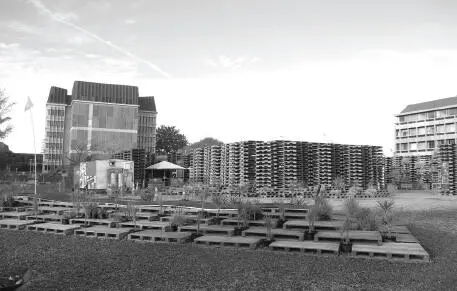
Pallet Pavilion by Gap Filler, Christchurch, 2013. Photograph by author
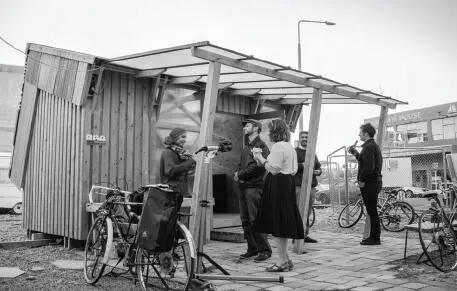
RAD Bikes by Gap Filler, Christchurch, 2013. Photograph by Erica Austin
Launch of Tunnel House Supper Club at FESTA 2014, Agropolis site. Photograph by Chloe Waretini
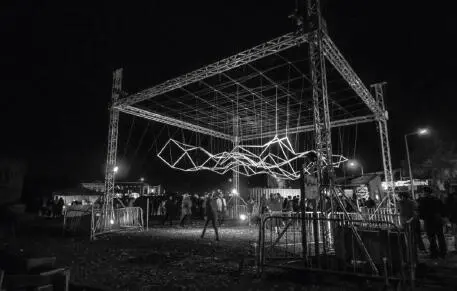
Installation Influx by architecture students from Unitec at FESTA 2014, Agropolis site. Photograph by Erica Austin
In 2014, Ryan Reynolds articulated this complexity and described living in a ‘post-city, the remains of a complicated, contradictory and post-colonial place’ and ‘a pre-city with three years worth of plans, consultations, ideas and designs that exist mainly as a massive set of aspirations to be enacted’. 14The time after the quakes was characterised by a range of incongruous mixtures of old and new, leading to a melding of:
–Broken things—80% of the central city was demolished over 4 years, 15
–New things—this led to the design and planning of thousands of new buildings, 16
–Normal things—that suddenly seemed older and more precious, 17
–Provision solutions— such as the 180 temporary projects between 2010 and 2013, 18
–Repaired old things—such as the city’s arts centre, 19
–Demolitions of old things—such as heritage buildings, 20
–Demolitions of new things—including buildings designed and finished after the quakes, 21
–The competition between new plans 22and outdated plans. 23
All these things co-existed, resulting in the mixing of objects and their temporalities. This particular urban setting is unique, but evidences the range of different types of temporal conditions that exist in any complex urban environment in which different projects, events and experiences are brought into being.
Spiral Time
As the city recovered, some of these rhythms were circular but formed as spirals. Spiral time is a circular time but with the perspective of change added to it. Political ecologist Jane Bennett writes that spiral repetition ‘is that sometimes that-which-repeats-itself also transforms itself. Because each iteration occurs in an absolutely unique context, each turn of the spiral enters into a new and distinctive assemblage— with absolutely local chirps, odours, herbs, thoughts, whirs, images, breezes, light waves, viruses, animals, machines, and minerals in its milieu.’ 24The change can be personal, contextual or environmental. For example, climate change has shifted the seasons from a circular predictable mode to a spiral one, in which we do not know what will come next.
Each season in Christchurch would be greeted by a different city—a place with more demolitions, new buildings and shifting temporary structures, fitting Bennett’s description of spiral time in which ‘each iteration occurs in an absolutely unique context.’ 25
Percolation
Percolation is the combination of many times together, of the experiences of linear, circular, archaic and future all bubbling and shifting around. In a 1995 interview, Latour asked philosopher Michel Serres if he thought time passed and he responded, ‘Yes, it passes, and also it doesn’t pass. We must bring the word pass closer to passoir —sieve. Time doesn’t flow; it percolates.” 26The aforementioned description of overlapping and multiple times invokes Serres’ notions of a world in which time is not linear and instead people are understood to move through different bubbles, rips and percolations. The presence of Agropolis in the city for three years and its eventual removal contributed to this sense of seasonal and repeating return but with change, and eventually this change became a bubble. For a time, it was one of the few stable things prior to becoming a remembered part of the city’s history in 2015. The planter boxes were given to another project and the earth shed was flatted back into the soil.
Turbulence
Turbulence is the temporality of apparent chaos. There may be order but it is either impossible to see or too complex to map. The fields of earthquakes are turbulent, there are statistical odds and geological patterns, but on the local level the impacts are sudden, often violent and entirely unpredictable. The turbulent is produced by the sudden presences and absences of forgotten patterns and quick returns.
Designing with Different Times
Agropolis shows how even the simplest of projects—a small urban farm—is part of a range of relationships, movements and events. Agropolis illustrated the joys of working with earth, soil, plants, waste, food, sunlight, seasons and the connections and movements shared by them and larger urban systems. This is a powerful contrast with the kinds of timeless or anti-temporal design that characterise many contemporary generic spaces such as malls, shopping centres and supermarkets, frequently designed with the intent to erase the passing of time by removing entities such as the sun, sky, shadows or time of day.
Earlier discussions explored viewing temporality as an ecology, as being constituted by experiences of permanence, temporariness, circular and repeating habits, the spirals of slow change and turbulences of uncertainty. Perhaps architecture might benefit if we gave more presence and better vocabulary to the actors—devices and humans—that do the work to sustain the things we often take for granted. In doing so, we might break away from understanding buildings as finished when constructed and towards a view of things that are both never quite finished and always being finished. An ecological approach suggests the boundaries of a project are of less importance that the movements through and over the border crossings along it. Ecologies have no final state; they exist as flows and movements and patterns of energy, nutrients and transformations. Perhaps our understanding of buildings as complex and living things increases when we give more presence to the flows, shifts, events and activities of buildings as they move through time.
Читать дальше
